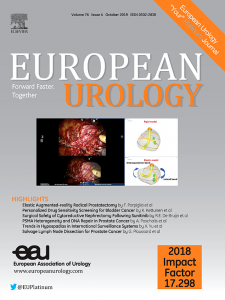非转移性前列腺癌术后放疗(DADSPORT)雄激素抑制的持续时间:一项综合数据的协作系统评价和荟萃分析
IF 25.2
1区 医学
Q1 UROLOGY & NEPHROLOGY
引用次数: 0
摘要
背景与目的为了更好地了解激素治疗(HT)与术后放疗(RT)在非转移性前列腺癌中的作用,DADSPORT协作计划对随机对照试验(RCTs)的总数据进行系统回顾和荟萃分析。方法对非转移性前列腺癌患者进行随访和术后放疗的对照研究。在最近的试验结果已知之前预先指定了方法(CRD42022325769)。主要终点是总生存期(OS);无转移生存期(MFS)和前列腺癌特异性生存期(PCSS)是次要结局。总结结果,包括预先指定的参与者亚组的结果,从研究人员那里获得,并使用固定效应荟萃分析将各试验结合起来。敏感性和网络荟萃分析评估了研究结果的一致性。5项随机对照试验(6项试验比较,4411名受试者;96%的合格患者被纳入初步分析。无明显证据表明HT可改善OS(风险比[HR] = 0.86, 95%可信区间[CI] = 0.74-1.00, p = 0.057;在8年时,绝对效应为2%[0-3.5%],或者效应随HT持续时间而变化(p = 0.6)。HT对OS的任何益处似乎仅限于放疗前前列腺特异性抗原水平较高(p = 0.07)和CAPRA-S评分较高(p = 0.09)的患者。HT显著改善MFS (HR = 0.78, 95% CI = 0.69-0.88, p <;0.001)和pc (HR = 0.61, 95% CI -0.79 = 0.47, p & lt;结论和临床意义术后RT后短期或长期HT可改善MFS和PCSS。观察到的OS改善很小,可能仅限于具有高风险因素的人群。本文章由计算机程序翻译,如有差异,请以英文原文为准。
Duration of Androgen Suppression with Postoperative Radiotherapy (DADSPORT) for Nonmetastatic Prostate Cancer: A Collaborative Systematic Review and Meta-analysis of Aggregate Data
Background and objective
To better understand the role of hormone therapy (HT) with postoperative radiotherapy (RT) for nonmetastatic prostate cancer, the DADSPORT Collaboration planned a systematic review and meta-analysis of aggregate data from randomised controlled trials (RCTs).Methods
RCTs evaluating HT with postoperative RT in people with nonmetastatic prostate cancer were identified. Methods were prespecified prior to results of recent trials being known (CRD42022325769). The primary outcome was overall survival (OS); metastasis-free survival (MFS) and prostate cancer–specific survival (PCSS) were the secondary outcomes. Summary results, including those by prespecified participant subgroups, were obtained from investigators and combined across trials using a fixed-effect meta-analysis. Sensitivity and network meta-analyses evaluated the consistency of findings.Key findings and limitations
Five RCTs (six trial comparisons, 4411 participants; 96% of all eligible) were included in the primary analysis. There was no clear evidence that OS was improved with HT (hazard ratio [HR] = 0.86, 95% confidence interval [CI] = 0.74–1.00, p = 0.057; absolute effect 2% [0–3.5%] at 8 yr) or that effects varied by HT duration (p = 0.6). Any benefit of HT on OS appears to be confined to people with higher pre-RT prostate specific antigen levels (p = 0.07) and CAPRA-S scores (p = 0.09). HT significantly improved MFS (HR = 0.78, 95% CI = 0.69–0.88, p < 0.001) and PCSS (HR = 0.61, 95% CI = 0.47–0.79, p < 0.001), with 4% absolute improvements for both outcomes at 8 yr.Conclusion and clinical implications
Short- or long-course HT after postoperative RT improves MFS and PCSS. Observed improvements in OS are small and may be limited to people with higher-risk factors.求助全文
通过发布文献求助,成功后即可免费获取论文全文。
去求助
来源期刊

European urology
医学-泌尿学与肾脏学
CiteScore
43.00
自引率
2.60%
发文量
1753
审稿时长
23 days
期刊介绍:
European Urology is a peer-reviewed journal that publishes original articles and reviews on a broad spectrum of urological issues. Covering topics such as oncology, impotence, infertility, pediatrics, lithiasis and endourology, the journal also highlights recent advances in techniques, instrumentation, surgery, and pediatric urology. This comprehensive approach provides readers with an in-depth guide to international developments in urology.
 求助内容:
求助内容: 应助结果提醒方式:
应助结果提醒方式:


